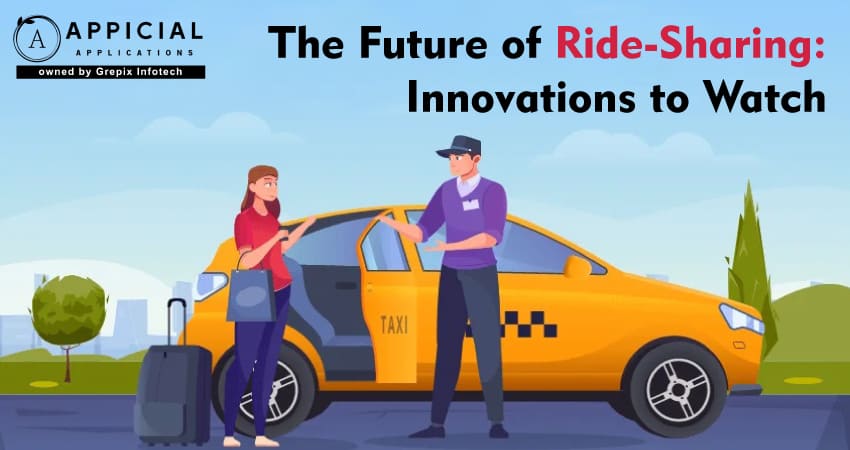
The Future of Ride-Sharing: Innovations to Watch
The future of ride-sharing is on the cusp of a significant transformation, driven by numerous innovations poised to enhance efficiency, sustainability, and user experience. As technology continues to advance at an unprecedented pace, the potential to revolutionize how we commute and interact with urban environments becomes increasingly tangible. This comprehensive exploration delves into the evolving landscape of ride-sharing, focusing on several key areas: the integration of autonomous vehicles, advancements in artificial intelligence (AI) and machine learning, the push towards electrification, emerging business models, and shifts in regulatory frameworks.
The future of ride-sharing is primed for transformative change driven by key technological advancements. Autonomous vehicles promise to dramatically reduce the need for human drivers, thereby decreasing costs and increasing accessibility. Advancements in AI and machine learning enhance efficiency through optimized routing and demand prediction, while electrification initiatives align with global environmental goals by reducing emissions. The introduction of new business models, such as multi-modal transportation options and subscription services, offers consumers more flexibility and convenience. As these innovations evolve, they will significantly impact urban mobility and redefine our commuting habits. This exploration delves into how these developments will shape the ride-sharing landscape, emphasizing the integration of these technologies and the necessary shifts in regulatory frameworks to accommodate and foster this growth.
Autonomous Vehicles: Steering Towards a New Era
One of the most groundbreaking developments in the ride-sharing industry is the advent of autonomous vehicles (AVs). The introduction of self-driving cars is anticipated to be a game-changer, fundamentally altering the dynamics of ride-sharing services. Once fully operational and integrated, AVs are expected to drastically reduce the need for human drivers, thereby lowering labor costs and potentially reducing fares for consumers. Major companies like Waymo, Uber, and Lyft are investing heavily in this technology, with pilot programs underway in select cities.
The true potential of AVs in ride-sharing lies in their ability to provide continuous, around-the-clock service without the limitations associated with human drivers, such as fatigue or scheduling conflicts. Vehicles operating independently can offer 24/7 availability, optimizing fleet utilization and increasing convenience for users. This constant availability can lead to reduced wait times and more efficient matching of supply and demand.
Furthermore, autonomous vehicles have the potential to improve traffic flow and reduce accident rates. Equipped with advanced sensing technologies like lidar, radar, and cameras, AVs can navigate complex urban environments with precision. Their programmed adherence to traffic laws and ability to communicate with other vehicles can lead to smoother traffic patterns and enhanced safety on the roads. According to studies, the widespread adoption of AVs could significantly decrease the number of traffic accidents caused by human error.
The integration of autonomous vehicles (AVs) into the ride-sharing ecosystem comes with its own set of challenges. Regulatory hurdles, technological limitations, and public trust issues need to be addressed. Ensuring the safety and reliability of autonomous systems is paramount, and extensive testing and validation are required before full-scale deployment becomes feasible. Additionally, there are concerns about job displacement for current ride-share drivers, which necessitates a thoughtful approach to workforce transition.
AI and Machine Learning: Crafting Smarter Ride-Sharing Systems
Artificial intelligence and machine learning are revolutionizing ride-sharing logistics and enhancing user experiences. These technologies play a crucial role in enhancing route optimization, predicting demand, and personalizing services. By analyzing large volumes of data, AI algorithms can identify potential hotspots for ride requests, enabling companies to allocate resources more efficiently and respond dynamically to changing needs.
Machine learning models process historical and real-time data to predict areas and times of high demand, enabling proactive positioning of drivers and reducing idle time. This results in more efficient use of the fleet and increased earnings for drivers. Route optimization algorithms consider traffic conditions, road closures, and passenger preferences to determine the most efficient paths, reducing travel times and fuel consumption.
Moreover, AI enhances customer interaction with ride-sharing app platforms through sophisticated chatbots and improved support systems. Natural language processing enables these chatbots to understand and respond to user inquiries effectively, providing assistance with booking rides, handling complaints, or answering general questions. This results in a more engaging and responsive user experience.
Personalization is another area where AI makes a significant impact. By analyzing user behavior and preferences, ride-sharing apps can offer tailored recommendations, such as preferred routes, vehicle types, or promotional offers. Predictive analytics can suggest travel times and destinations based on past behavior, making the booking process more intuitive and convenient.
Also Read: From Idea to App Store: The Development Journey of a Bolt Clone
Electrification of Ride-Sharing Fleets: Driving Towards Sustainability
Electrification represents a critical frontier for the ride-sharing industry, aligning with global efforts to combat climate change and reduce carbon emissions. With increasing environmental concerns and regulatory pressures, ride-sharing companies are progressively shifting towards electric vehicles (EVs). This transition not only helps in curbing pollution but also reduces dependency on fossil fuels.
Companies like Uber and Lyft have already committed to electrifying their fleets. Uber's "Green Future" program aims to become a fully electric mobility platform in certain markets by 2030, offering financial incentives to drivers who switch to EVs and partnering with automakers to provide affordable options. Lyft has announced similar initiatives, striving for 100% electric or zero-emission vehicles on its platform by the end of the decade.
The adoption of EVs in ride-sharing fleets offers several advantages. Electric vehicles have lower operating costs due to reduced fuel and maintenance expenses, as they have fewer moving parts compared to traditional combustion engines. These cost savings can potentially be passed on to consumers in the form of lower fares. Additionally, EVs provide a smoother and quieter ride experience, enhancing passenger comfort.
Emerging Business Models: Expanding the Ride-Sharing Ecosystem
The ride-sharing industry is witnessing the emergence of innovative business models that challenge traditional approaches and expand the scope of services offered. One such innovation is the integration of multi-modal transportation options within a single platform. Ride-sharing apps are evolving into comprehensive mobility solutions, offering not only car rides but also access to scooters, bikes, and even public transit tickets.
This approach provides users with a versatile set of transportation choices tailored to their specific needs, distances, and preferences.
For example, a user might opt for an electric scooter for a short trip in a congested urban area or choose a shared bike for a leisurely ride. Integrating public transit options allows users to plan end-to-end journeys within the app, combining ride-sharing with buses or trains for optimal efficiency and cost-effectiveness.
Subscription-based models are also gaining traction in the ride-sharing sector. These models offer users a recurring fee for a package of rides or unlimited access to various modes of transport. Such arrangements cater to regular commuters, providing predictable costs and convenience. For operators, subscription models create a steady revenue stream and foster customer loyalty.
A growing trend is peer-to-peer car sharing on ride-sharing platforms. This model enables car owners to rent out their vehicles when not in use, turning idle assets into income-generating opportunities. It promotes a more sustainable use of resources and offers users a wider selection of vehicles.
Additionally, ride-sharing companies are exploring the delivery and logistics market, leveraging their existing networks to offer food delivery, package transport, and courier services. This diversification not only opens up new revenue streams but also maximizes fleet utilization.
Regulatory Environment: Navigating the Changing Landscape
As ride-sharing becomes more ingrained in the transportation infrastructure, regulatory frameworks are evolving to keep pace with technological advancements and societal changes. Governments and city planners recognize the need to integrate ride-sharing formally into urban planning and public transport policies. Regulations are being crafted to ensure safety, promote fair competition, and encourage innovations that align with broader societal goals, such as reducing traffic congestion and lowering emissions.
Safety regulations may include thorough background checks for drivers, inspections to verify vehicle safety, and mandatory insurance coverage requirements. When it comes to autonomous vehicles, regulators encounter the challenge of creating standards for testing and deployment. They must also address liability issues and ensure cybersecurity to protect against potential hacking threats.
Environmental regulations are pushing ride-sharing companies towards greener practices. Policies such as emission caps, congestion pricing, and incentives for zero-emission vehicles aim to mitigate the environmental impact of increased ride-sharing activity. Some cities are implementing designated zones where only electric or low-emission vehicles can operate.
Conclusion
Appicial Applications a leading taxi app development company delves into the future of ride-sharing, and it's clear that the industry is poised for a substantial transformation driven by innovation and technological advancement. Integration of autonomous vehicles promises to redefine the economics and accessibility of ride-sharing, making services more cost-effective. AI and machine learning are set to refine operational efficiencies and elevate the user experience, personalizing interactions and optimizing routes in real time. Meanwhile, the shift towards electrification aligns ride-sharing with global sustainability goals, reducing carbon footprints and fostering a greener future.
Emerging business models are expanding the ride-sharing ecosystem beyond traditional boundaries, incorporating multi-modal transport solutions and peer-to-peer sharing to enhance flexibility and resource utilization. Subscription services and the integration of public transit options are creating more cohesive and user-friendly transportation networks. These innovations are not only improving service delivery but are also setting the stage for new market opportunities and consumer engagement strategies.
Appicial Applications continues to monitor and adapt to these trends, the ride-sharing industry looks set to offer more dynamic, efficient, and sustainable transportation options. This evolving landscape presents both challenges and opportunities to enhance urban mobility and redefine the way we think about commuting and city planning in the future.
Looking out to start your own venture like Uber? Try out our HireMe Uber Clone, the easiest way to kick-start your taxi business.




